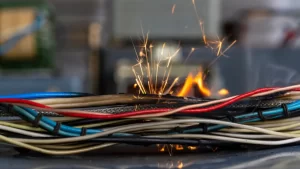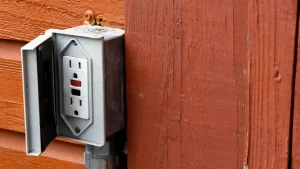The Hidden Danger Behind Your Walls
Most homeowners worry about obvious fire risks like overloaded power strips or old appliances. But one of the biggest dangers hides quietly behind your walls: loose wiring connections.
These small gaps between wires and terminals may not seem like a big deal, but they allow electricity to jump, creating tiny sparks called arcs. Over time, those arcs generate heat that can ignite insulation or nearby materials.
The worst part? You often can’t see or hear these problems until it’s too late. At NWA C&S Electric, we see this issue often during home inspections or repair calls, and in many cases, the homeowner had no idea their wiring was unsafe.
How Loose Connections Happen
Loose wiring doesn’t happen overnight. It develops slowly due to a mix of time, temperature, and vibration. Here are some of the most common causes:
- Aging Wiring: Over the years, wires naturally expand and contract as temperatures change. This movement can loosen terminal screws or wire nuts.
- DIY Repairs: Homeowners sometimes tighten connections by hand without using the right torque, or use the wrong connectors entirely.
- Overloaded Circuits: Circuits carrying too much current can heat up, softening insulation and loosening connections.
- Frequent Vibration: Ceiling fans, HVAC systems, or washing machines can shake walls and junction boxes, slowly loosening wires.
These factors can affect both older and newer homes. Even if your house is only a few years old, improper installation can still create a hidden hazard.
Warning Signs of Loose or Faulty Wiring
Electrical fires rarely start without warning. If you know what to look for, you can catch issues before they become serious. Here are some signs your home may have loose connections or faulty wiring:
- Lights that flicker or dim when you use certain appliances
- Outlets that feel warm or make crackling sounds
- A burning smell near switches, outlets, or your breaker panel
- Frequent breaker trips or blown fuses
- Outlets that don’t hold plugs securely
If you notice any of these issues, it’s time to call a licensed electrician. Ignoring these signs can lead to overheating and arcing that could start a fire.
Why This Hazard Is Overlooked
Loose connections are easy to miss because they’re invisible. You can’t spot them during normal daily use, and they often don’t cause immediate problems.
Many homeowners assume that if their lights work, everything is fine. But electricity doesn’t need a visible spark to be dangerous. Even a slightly loose wire can heat up hundreds of degrees in seconds.
Unlike major appliances or extension cords, wiring is out of sight and out of mind. That’s what makes it such a silent threat.
The Science of Arcing and Heat Buildup
When a wire connection isn’t tight, electricity struggles to move smoothly. Instead of flowing in a steady stream, it jumps across tiny gaps. This jumping, called arcing, produces both light and heat—similar to a miniature lightning bolt.
A single arc might not seem like much, but over time, it can degrade insulation and create carbon build-up. That buildup increases resistance, causing even more heat. Eventually, nearby materials can ignite.
Modern electrical systems include protective devices like circuit breakers and AFCIs (Arc Fault Circuit Interrupters), but these can’t catch every problem. That’s why regular inspections are still vital.
Outdated Wiring Compounds the Risk
Older homes built before the 1980s often use wiring types that are more prone to loose connections, such as:
- Aluminum wiring: Expands and contracts more than copper, loosening over time.
- Cloth-insulated wiring: Degrades with age, making connections brittle.
- Knob-and-tube wiring: Common in very old homes and lacks modern grounding protection.
If your home uses one of these systems, it’s time to schedule a professional inspection. NWA C&S Electric specializes in identifying and upgrading outdated wiring before it becomes a danger.
Preventing Electrical Fires Through Maintenance
The best defense against electrical fires is routine maintenance. Homeowners should schedule a professional electrical inspection every 3–5 years or sooner if their home is more than 25 years old.
During an inspection, a licensed electrician will:
- Check outlets and switches for loose terminals
- Tighten connections in the breaker panel
- Inspect visible wiring for damage or discoloration
- Test circuits for arcing or irregular voltage drops
Our team at NWA C&S Electric provides comprehensive safety checks to ensure every connection is tight, secure, and up to code.
Other Overlooked Fire Hazards to Watch For
While loose connections are the leading overlooked cause, a few other hazards often go unnoticed:
- Overloaded power strips behind TVs or computers
- Improperly rated extension cords used for heavy appliances
- Dust buildup around outlets and electrical panels
- Old light fixtures without modern insulation or wiring
Each of these issues can cause excessive heat, increasing the risk of a fire. Fortunately, they’re easy to fix once identified.
Why Professional Inspections Matter
Electrical systems are complex, and small issues can escalate quickly. Hiring a professional electrician ensures problems are found early and handled safely.
At NWA C&S Electric, our licensed electricians use advanced diagnostic tools to detect hidden problems behind walls, in ceilings, or inside your breaker panel. We identify and repair hazards before they become emergencies.
Our goal is to leave every home safer than we found it.
Conclusion
The most overlooked electrical fire hazard in your home is likely a loose wire hidden behind your walls or outlets. These small, silent issues can cause dangerous arcing and heat buildup over time.
By scheduling regular inspections, upgrading outdated wiring, and staying alert to warning signs, you can dramatically reduce the risk of an electrical fire.
If you suspect wiring issues or just want peace of mind, contact NWA C&S Electric. Our professional electricians proudly serve all of Northwest Arkansas, providing safe, reliable, and thorough electrical inspections and repairs.
Your home’s safety starts with strong connections—literally. Let our team help you protect what matters most.



